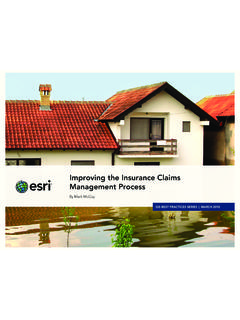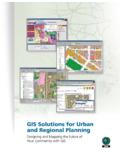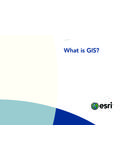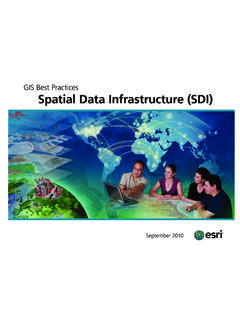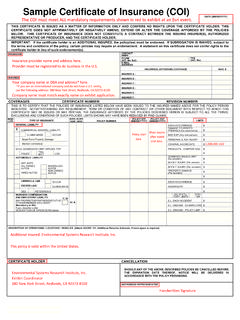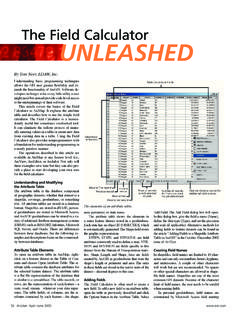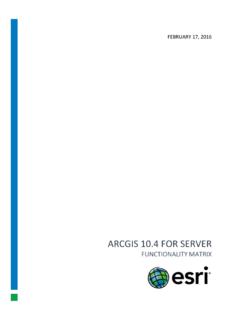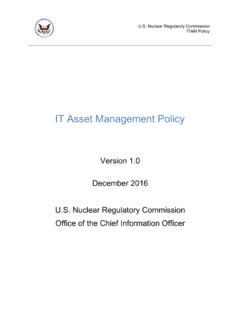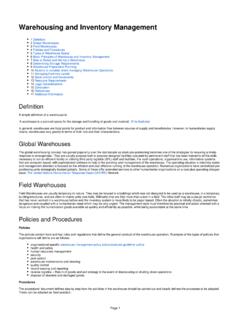Transcription of GIS Solutions for Civil Engineering - Esri
1 GIS Solutions for Civil EngineeringThe Modern Platform for Civil ITSpatial AnalysisGIS provides tools for modeling information to support more intelli-gent, faster decisions; discover and characterize geographic patterns; optimize network and resource allocation; and automate workflows through a visual modeling environment. GIS Solutions for Civil EngineeringCivil Engineering is about developing and sustaining infrastructure. The profession covers many areas of interest and a broad range of expertise. As a result, Civil engineers work with a voluminous amount of data from a variety of sources. Geographic information system (GIS) technology provides the tools for creating, managing, analyzing, and visualizing the data associated with developing and managing infrastructure. GIS allows Civil engineers to manage and share data and turn it into easily understood reports and visualiza-tions that can be analyzed and communicated to others. This data can be related to both a project and its broader geographic context.
2 It also helps organizations and governments work together to develop strategies for sustainable development. Thus, GIS is playing an increasingly important role in Civil Engineering companies, supporting all phases of the infrastructure life GIS? GIS software is interoperable, supporting the many data formats used in the infrastructure life cycle and allowing Civil engineers to provide data to various agencies in the required format while main-taining the data s core integrity. GIS technology provides a central location to conduct spatial analysis, overlay data, and integrate other Solutions and systems. Built on a database rather than individual project files, GIS enables Civil engineers to easily manage, reuse, share, and analyze data, saving time and resources. Author, Serve, UseGIS lets you easily author data, maps, globes, and models on the desktop; serve them to a GIS server; and use them through Web, desktop, and mobile clients. UseServeAnalysis & Modeling ServicesMap ServicesGlobe ServicesGeodata ServicesAdditional ServicesAuthorDesktop GISD esktopCADOpen APIsMobileRich ClientsBrowser ApplicationEnterprise Integration PlatformLidarSurveyCADI mageryPhotogrammetryDataVisualization and CartographyThrough the use of 2D and 3D clients, you can experience a more interactive way of seeing data, visualizing change over time and space to identify patterns and trends, and disseminate knowledge to engineers, managers, clients, regula-tors, and field-based Data ManagementGIS organizes and manages geographic information to support fast and efficient visualization and analytic applications, regardless of the amount of data held within an organization.
3 Agencies securely store and manage vast amounts of spatial information and propagate data changes between multiple data sources. Analyze, visualize, and manage all your data with centralized information system based on ESRI GIS software provides Civil engineers with the IT framework for maintaining and deploying criti-cal data and applications across every aspect of the infrastructure project life cycle including planning and design, data collection and manage-ment, spatial analysis, construction, and operations management and architecture provides the tools to assemble intelligent GIS applications and improve a project process by giving engineers, construction contractors, surveyors, and analysts a single data source from which to work. Centrally hosting applications and data makes it easy to manage, organize, and integrate geographic data, including CAD data, from existing databases to visualize, analyze, and make decisions. The system helps combat data communication errors, eliminating the need for multiple, flat files in disparate Life Cycle PlanningIt contains high-level planning functions for site location including environmental impact mitigation, economic analysis, regulatory permitting, alternative siting analysis, routing utilities, what-if scenarios, visualization of concept options, data overlay, modeling, and benefit/cost alternatives CollectionIt has specific functions to collect precise site data used for predesign analysis; design.
4 And calculations including field survey, topography, soils, subsurface geology, traffic, lidar, photo-grammetry, imaging, sensitive environmental areas, wetlands, hydrology, and other site- specific design-grade AnalysisIt provides analysis to support design including hydrology analysis, volume calculations, soil load analysis, traffic capacity, environmen-tal impact, slope stability, materials consumption, runoff, erosion control, and air emissions. During environmental analysis, view project maps, site photos, CAD files, survey measurements, and 3D renderings. Analysis of the environment with a GIS allows you to view patterns, trends, and relationships that were not clearly evident without the visualization of allows creation of new infrastructure data for new Civil works including grading, contouring, specifications, cross sections, design calculations, mass haul plans, environmental mitigation plans, and equipment staging. This includes integration with traditional design tools such as CAD and databases for new design provides the mechanics and management for building new infrastructure including takeoffs; machine control; earth movement; intermediate construction, volume and material, and payment calculations; materials tracking; logistics; schedules; and traffic Collection As-Built SurveyingGIS provides the tools to collect precise site data and document existing conditions.
5 With as-built surveying infrastructure data, operators use defined, operational, industry-standard data models. As-built surveying with GIS technology permits the surveyor to deliver data into opera-tional GIS, eliminating costly data conversion and reducing models utility and infrastructure networks and integrates other related types of data such as raster images and CAD drawings. Spatial selection and display tools allow you to visualize scheduled work, ongoing activities, recurring maintenance problems, and his-torical information. The topological characteristics of a GIS database can support network tracing and can be used to analyze specific properties or services that may be impacted by such events as stop-pages, main breaks, and drainage CollectionData Collection As-Built SurveyingArcGIS ServerAn Engineering information system based on enterprise GIS technology stream-lines activities from field data collection to project management . With this single relational database, you are connected to all your clients; construction sites; and inventory , network, and maintenance server-based data management environment leveraging GIS capabilities promotes efficient workflows in data and project management .
6 It allows you to streamline your work processes in data capture, editing, analysis, visualization, and design. With an ability to communicate changes to an entire team rapidly, GIS gives your entire team access to the most current information supporting better decision making. GIS enhances workflows in Project management Analysis and design LogisticsGIS provides Data accuracy Data sharing Analysis capability ModelingWorkflowCase Study GIS Technology Refines Flood Insurance Rate Mapping ProcessIn response to FEMA s billion-dollar Map Modern-ization program to produce Digital Flood Insurance Rate Maps (DFIRMs), Dewberry, a Virginia-based Engineering , surveying, and GIS firm, developed GeoFIRM, an enterprise-level automated engi-neering, map production, and workflow system. GeoFIRM relies on a multiuser centralized GIS geodatabase that makes it possible for DFIRM project members spread throughout the country to instantaneously view data; easily edit the data-base; and readily access Dewberry DFIRM project data such as digital imagery, orthophotography, scanned paper maps, lidar, and Engineering data.
7 Using the geodatabase-centric ArcSDE technology in ArcGIS , GeoFIRM is Dewberry s central reposi-tory for Engineering and mapping spatial and nonspatial DFIRM data. A series of automated toolkits was built using the ArcObjects technology inside ArcGIS to assist project members in DFIRM production. The toolkits facilitate the DFIRM modeling process automatically by managing the input and output requirements for each model or task. The custom-created toolkits in GeoFIRM have increased Engineering accuracy and quality while drastically reducing Flood Insurance Rate Map product cost and time. Create 3D views to analyze and view data from any angle or CreationVisualizationInternet: Data Access, Citizen PortalsAnalysisMobile Field-WorkersMapping and ReportingDesignModeling and AnalysisGeoprocessing is the framework for modeling and analysis. Some of the common modeling applications include Composite overlay models for assessing suitability, sensitivity, capacity, and risk Evaluation models for comparing alternatives Growth models for assessing future conditions Statistical models for assessing trends and generating predictive surfacesThe geoprocessing framework can also be used for integrating external models, sharing models with others, documenting a spatially dependent decision process, and developing interactive decision support systems.
8 Land UseHydrologyBufferMergeMergePopulated AreasSuitable HabitatUninhabitable RegionsAcceptable Land UseRoadsExtracted by AttributeExcludeBioregionNear WaterCreate new data by combining existing and analyze flood zones by combining hydrological, envi-ronmental, and geological Integration, Visualization, and ManagementYou can use GIS to combine and interpret data from many different formats. GIS allows you to integrate satellite images, CAD drawings, and parcel maps to create a visual overview of a project and turn it into easily understood reports. It accepts CAD data without conversion and includes it as a layer in a GIS geodatabase gives you the ability to handle rich data types and apply sophisticated rules and relationships. In addition to managing large volumes of geographic data, it also implements sophisticated business logic that, for example, builds relationships between data types such as topologies and geometric net-works, validates data, and controls access.
9 Data management tools scale to meet your needs, from the individual to workgroups and large, multiuser enterprises. Case Study GIS System Model Integration Facilitates Storm Water ManagementAgencies throughout the country responsible for storm water management generally require drain-age reports for development and master plans for overall major drainage improvements. Although agencies have drainage manuals to guide the analy-sis for the reports and master plans, the consistency of submissions varies considerably, and significant time and effort are required in the review process. KVL Consultants, Inc., has developed database management systems (DBMS) linked to ArcGIS to facilitate the submission process and reduce agency review time. The integration with ArcGIS is automated from the DBMS and contains all the data needed to run specific hydrology and hydraulic models and uses agency default procedures and parameters to provide consistent results. ArcGIS is used as a front-end data loader for modeling and on the back end to show the modeling results.
10 Applications are currently in use by the Flood Control District of Maricopa County, Fresno Metropolitan Flood Control District, and Mohave County and Clark County Regional Flood Control integration and interoperabil-ity capabilities of ArcGIS with many other products offer complete flexibility in workflow data management tools in ArcGIS scale to meet your needs, from the individual to workgroups and large, multiuser data integration capabilities of ArcGIS make it a powerful tool for modeling and for visualizing assets and the surrounding environment when you build, upgrade, and repair infrastructure helps you decide how to prioritize your work, convince others of its importance, and make good decisions about how to move forward with your plans. Having an accurate, clear picture of the project helps you better understand needs, reduce problems, and mitigate costs and environmental impacts. These processes are improved when GIS is the core system for data management and all the demands on your time, using tools that streamline your business processes and provide you with the best mapping and visualization makes sense.
